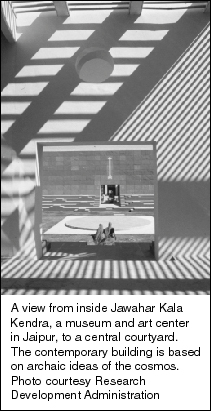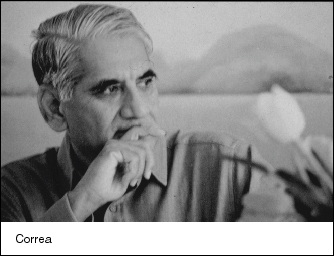The University Record, February 22, 1999
Charles Correa: An architect of range and sensitivity
Editor’s Note: This article is one in a series of profiles about U-M alumni who have made significant and lasting contributions through their research, scholarship and creative activity. Expanded versions of these articles are available on the U-M research Web site at www.research.umich.edu/research/news/michigangreats.html.
By Lee Katterman
Office of the Vice President for Research
 In a career that spans the design of great buildings and cities to plans for effective, affordable housing, few can match Charles Correa’s accomplishments. Born in India in 1930 and still practicing there today, this 1953 graduate of the College of Architecture and Urban Planning (CAUP) is a major figure in contemporary architecture.
In a career that spans the design of great buildings and cities to plans for effective, affordable housing, few can match Charles Correa’s accomplishments. Born in India in 1930 and still practicing there today, this 1953 graduate of the College of Architecture and Urban Planning (CAUP) is a major figure in contemporary architecture.
From museums to government buildings, universities to apartments for low-income families, Correa has left his mark. “In addition to his many architectural works built on the Indian subcontinent and all over the world, Correa has been one of the pioneers in developing frugal, culturally-rooted shelter in the developing world,” says CAUP Dean Douglas Kelbaugh.
A catalogue of Correa’s many accomplishments includes the Mahatma Gandhi Museum in Ahmedabad, built in the 1960s; the Jawahar Kala Kendra Museum in Jaipur, constructed a decade ago; and the recently completed Bhopal State Assembly Building, which last year received an Aga Kahn Award, a prestigious award given to distinguished works of architecture in the Muslim world.
In 1964, Correa and two colleagues proposed the planning concepts that formed the basis for “New Bombay,” a development for two million people that sought to change the existing urban structure in the Bombay metropolitan region. These and other projects, such as the low-income Previ Housing project in Peru, utilize many of the same architectural principles put to use in his commissioned works.
Brian Carter, professor of architecture and chair of the CAUP architecture program, notes that Correa’s designs “respond to the climate of India. His vocabulary is of today, yet derived from the physical setting and many traditional values of Indian society.”
 Correa calls for locally available building materials of brick and masonry and the local craftspeople who have been using these materials for centuries, explains Carter, while taking cues from Western technology in his designs. His housing designs use courtyards and screens that shield residents from the hot sun and expand the useful living area according to the season of the year.
Correa calls for locally available building materials of brick and masonry and the local craftspeople who have been using these materials for centuries, explains Carter, while taking cues from Western technology in his designs. His housing designs use courtyards and screens that shield residents from the hot sun and expand the useful living area according to the season of the year.
Asked recently to describe the role of the architect, Correa said, “In India, there are traditional ways of building habitats that are wonderfully ingenious—and beautiful! These typologies also yield high densities, since Indian families are used to small overall areas with a high occupancy per room. The only problem, of course, is that many of these traditional solutions aren’t viable in the urban context we have created. What we must do then is modify that urban context so that those solutions became viable. That is the role of the architect.”
Correa initially studied in India at St. Xavier’s College in Bombay in 1946-48. He then came to the United States, where he earned his B. Arch. in 1953 from the U-M. He received an M. Arch. from MIT in 1955. He established a private practice in India in 1958.
Correa received an honorary doctor of architecture degree from the U-M in 1980. In 1984, He was awarded the Gold Medal of the Royal Institute of British Architects. He has been honored by many national and international organizations, including receipt of the 1985 Prize for the Improvement in the Quality of Human Settlements from the International Union of Architects.
The work of Correa and others in India will be the focus of a new CAUP initiative. The “India Program” will offer a graduate studio and related courses for architecture and urban planning students in Ahmedabad, India, hopefully starting next fall. The India Program will be run in collaboration with Ahmedabad’s School of Architecture.
“Correa is a very good example for our students,” Kelbaugh says, by showing them that an illustrious career need not solely involve big projects for major clients. “There is no one comparable in the United States. No one practices with this range, because the situation here, alas, is much different, favors greater specialization.”

